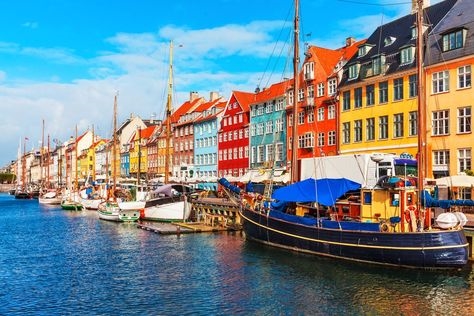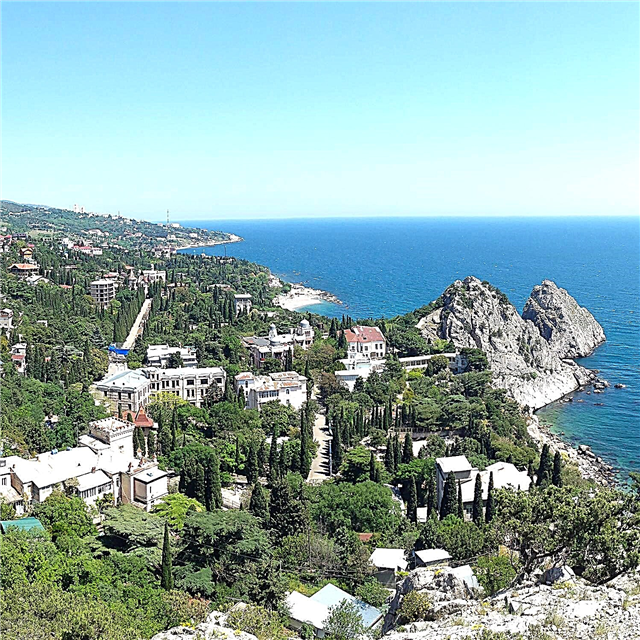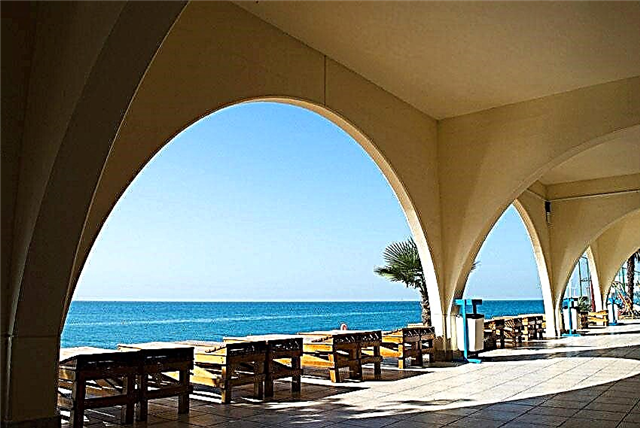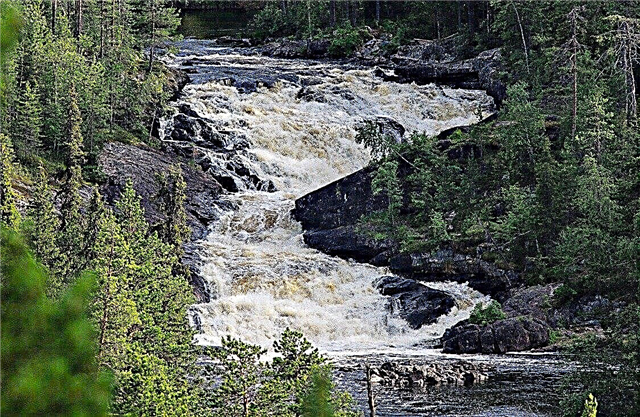Excursions and tours with a visit to water rapids and waterfalls - the locals call them "paduns" - are very popular among tourists in Karelia. Every year these unique creations of nature attract numerous lovers of pristine nature from different parts of Russia and around the world. They come here to admire the power and magnificent spectacle of the combination of two elements - water and stone.
Beautiful waterfalls and river rapids in Karelia
Kivach
The pearl of Karelia, its business card. The snow-white cascading waterfall on the Suna River, framed by the lush greenery of centuries-old forests, is an unforgettable sight. The waterfall is located on the territory of the reserve of the same name. On the European plains, it is second in size only to the Rhine Falls in Switzerland. The height of the fall of water from 4 ledges is almost 11 meters. The waterfall itself and the surrounding area, including the arboretum and the museum of nature, are very popular among tourists.

Yukankoski (White Bridges)
The famous waterfall is located on the Kulismajoki River, surrounded by a dense forest, 10 km from the village of Leppäsilta. It reaches a height of 19 meters and is considered the highest in southern Karelia. The name "White Bridges" was given to the waterfall thanks to the white-stone bridges built upstream of the river, from which little has survived today. The waterfall has two arms. One of them is more powerful, the second is located 50 meters away, it is smaller, but not inferior to the main thing in beauty.

Akhvenkoski (Ruskeala)
The most famous waterfalls in southern Karelia are Ruskealsky, on the Tohmajoki river, in the territory of a natural park. And among them, Ahvenkoski - "Perch's Threshold" stands out for its power and splendor. It is located a few kilometers from the village of Ruskeala. Akhvenoski is one of the 4 Ruskeala waterfalls 3-4 meters high, popular among fans of extreme sports and water tourism. There are benches, gazebos installed on the shore, and there is a car platform. Nearby you can see the ruins of a hydroelectric power station.

Girvas
It is located on the Suna River, near the village of the same name. Thundering streams of water rush up the steps from a height of 15 meters and flow into the picturesque Palleozero. The bed of the waterfall is formed by volcanic rocks, whose age is estimated at billions of years. Sometimes the waterfall turns into a thin trickle. This happens when water flows are diverted for the needs of the nearby Sunskaya HPP. To fully enjoy the full power of the waterfall, you should visit it in May - during the spillway from the power plant.

Kivakkakoski
"The Stone Woman's Threshold" - this is how the name of the waterfall is translated - is located on the Olanga River, in the territory of the national park. The height of several of its cascades is 12 meters, the horizontal length is 100 meters. It takes 3rd place in Europe in terms of water flow. Nearby there is a mountain - the same Kivakka or Stone Baba, after which the waterfall is named. It is famous for its seids - huge cult stone objects of the Sami culture.

Mäntykoski
Translated from Finnish, the name of the waterfall on the Mäntüjoki River means “pine threshold”. It cannot be called impetuous, noisy and abounding in water, but the fact that it is one of the most spectacular and picturesque in Karelia is for sure. The waterfall is located in the national park, surrounded by magnificent nature. Its calm, quietly murmuring streams flow down several steps of the stone cascade. And in summer, the water warms up so well that you can even swim.

Kumi threshold
One of the most famous waterfalls in Karelia is located on the Voinitsa River, on the border with eastern Finland, and has the status of a natural monument. It is a fascinating sight throughout the year, but especially in winter, when it resists severe frosts and does not allow itself to be chained into an ice shell. The height of the fall of the Kumi water flows is 18 meters, the roar is heard from them several kilometers away, especially in May-June, when the Voinitsa is at its fullest.

Voitsky Padun
The second name of the waterfall on the Nizhny Vyg River is Voets, it has been known since the 16th century. Once the waterfall was stormy and deafening, it is not for nothing that the nearby village was named Nadvoitsy, that is, located above the howl. Initially, it had 3 branches, only one has survived to this day - the Sredinnaya Pad ', but it rather resembles a small threshold on the river. The waterfall lost its former power in the 30s of the last century, when the hydroelectric power station blocked the river, and its waters flowed along a new channel.

Pöyuhinkoski (cascade on the Pukamonjoki river)
The name of the waterfall is translated as "agitator". This is how all such waterfalls are called in Karelia, the jets of which stir up numerous piles of stones and throw them from place to place. The Pukamonjoki River flows in a picturesque place - surrounded by a forest, among stones covered with white water foam. It forms a 40-meter cascade, consisting of several ledges of different heights. The waterfall is especially spectacular and full-flowing in spring, and in summer its waters become very shallow.

Roskelakoski (Andronino)
A stream originates from Lake Satisenjärvi or Andronino, which runs along the canyon, and then flows down the rocky slope of the Valkeanmäki ridge from a height of 10-15 meters. This is the Andronovsky or Roskelakoski waterfall, the name of the village located nearby. In the warm season, you can swim under the streams of the waterfall. Although it is located in a hard-to-reach place, and, as a rule, it is not crowded here.

Sirnitsankoski (Pink Elephant)
Rapid waterfall on the Uksunjoki river. A rock slab divides the powerful stream of water into two jets. The total difference in height is about 2.5 meters. The name of the waterfall was given by a large pink stone located a few meters from it. In this area, there is a popular river rafting route, but you can successfully pass the rapids only until mid-June, later shallow water begins. There are equipped parking lots for water tourists on the shore.

Lower Koirinoya
It is located in the lower reaches of the Koirinoi River, not far from the place where it flows into Lake Ladoga. This picturesque waterfall is often called Strawberry Falls - there are many berries in its vicinity. It is surrounded by granite rocks of a delightful pink hue. The waterfall has another original feature that attracts kayaker tourists. The water runs along a narrow chute and at the end shoots out like a water cannon. The height of the waterfall is low - 4 meters.

Upper Koirinoya
Located upstream of the Koirinoi River, in the village of the same name, on the site of the old abandoned dam of the Finnish hydroelectric power station. A picturesque and fairly safe threshold is like a slide, from which water jets flow down in a uniform stream. Its height is 4.7 meters. Less interesting than the lower waterfall, but in the warm season, kayakers are frequent visitors to this waterfall, and in winter, locals ride from the ice slide on a sled.

Ryumyakoski
The waterfall was formed in the bed of the Tohmajoki River, near the hydroelectric power station restored in 2012, which supplies electricity to the nearest villages of Kaalamo and Ruskeala. A powerful stream of water from a height of 8-9 meters falls into a picturesque lake surrounded on all sides by rocks. This area is well known to extreme tourists. The route of rafting on the river on catamarans and kayaks passes right through the waterfall and has one of the highest categories of difficulty.

Myllykoski
The waterfall is located on the Myllyjoki river, where it flows into Lake Yukayarvi. The name translates as "mill stream", before there really was a mill with a sawmill, then a small power station was added. Today, only ruins remain of these buildings. The total length of the waterfall is 60 meters, the height of the largest rapids is 3 meters. A small stone island divides the waterfall into two branches, and when it flows into the lake again merges together.

Prokinkoski
A small and not very popular waterfall is located not far from the road, in the wilderness, on the Khikhniyoki River. In addition to its official name, it also has another - "May 9", as the locals call it. In the last century, the Finns built a hydroelectric power station here, today only destroyed concrete supports, covered with green moss and shrubs, are left of it. The height of the waterfall is 4 meters; by a small island it is divided into two branches.

Kiviristi
The rapids-waterfall on the Okhta River in northern Karelia is small, but very powerful, it is considered one of the most difficult and risky in terms of passage on catamarans and kayaks. But due to its unpredictability and increased danger, it is even more attractive for extreme water enthusiasts. The waterfall consists of three steps, the second is the most difficult to pass, is a large drain between two huge stones, has the 4th category of difficulty. The total length of the waterfall is about 300 meters.

Padun on the Vodla River
There are about 20 rapids of various difficulty levels on the Vodla River, the Padun waterfall is the most famous, wide and beautiful of them. It is located 200 meters from an abandoned village on the right bank of the river. If you float on the water, the threshold may not be noticed, but the rumble of falling water streams is heard far away. The difference in height across the entire width of the river is about 2 meters. A popular tourist water route passes through the waterfall.

Laskela
A large waterfall on the Janisjoki River, its height is 13.4 meters, its length is about 50 meters. It has a steep slope and rocky shores. It is the channel of the hydroelectric dam spillway in the village of Lyaskelia. The waterfall is extremely noisy and drowns out all sounds in the surrounding area. More than a hundred years ago, a pulp mill was built here, and then the first hydroelectric power station appeared, supplying the enterprise with electricity. Recently it was modernized and transferred to automatic control.

Harlu (Leppäkoski)
The Leppäkoski rapids-waterfall, which means "Olkhovy" in translation, is located on the Janisjoki River, on the territory of the village of Kharlu. Previously, it was an important link in the production of cellulose in the republic. From a local woodworking enterprise, raw materials were supplied to a paper mill in Läskelä, and a hydroelectric power station was built nearby. Today, all production has been destroyed and abandoned, and only the dam of the hydroelectric power station, built with conscience, restrains the rapid rumbling streams of Janisjoki.












